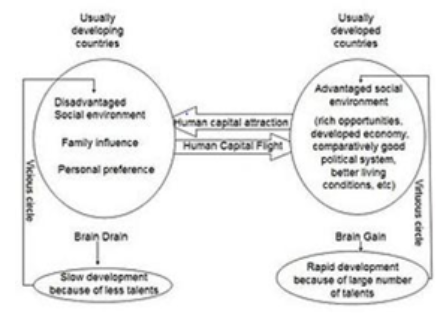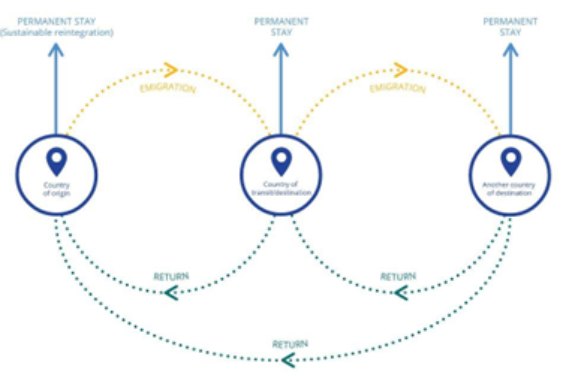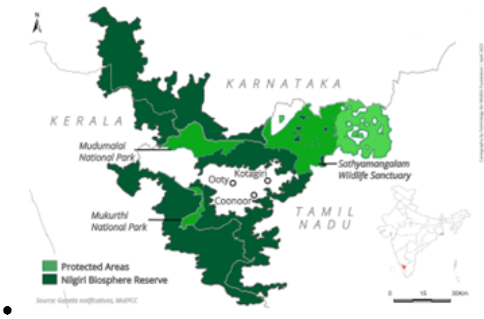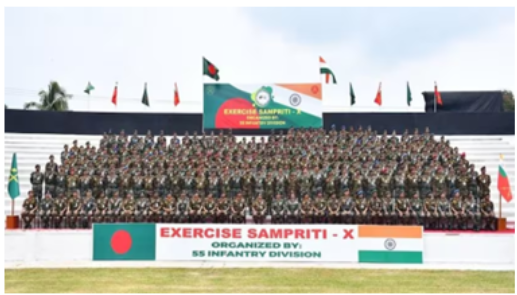Thursday, 5th October 2023
Circular Migration: Two Sides of the Debate
In News: In India, internal migration, which is migration within a particular country or State, has almost always been circular. With rapid industrialisation, there has been a huge flow of migrants from rural areas to urban cities.
About Circular Migration:

- Circular migration is a repetitive form of migration wherein people move to another place (the destination country) and back (country of origin) according to the availability of employment.
- This means that instead of migrating permanently or temporarily (i.e. for a period of time to complete any contract-based labour) to another location, people move to different locations for a brief period of time when work is available.
- It is a phenomenon mostly among low-income groups who migrate to avail of seasonally available jobs in another country, city, place etc.
- According to the United Nations Economic Commission for Europe Task Force, one is called a circular migrant if the person has completed at least ‘two loops’ between two countries.
Impacts of International Circular Migration:

- Benefits for migra
- Increased earnings: Circular migrants often earn more money in the destination country than they would in their country of origin.
- Improved skills: Circular migrants can learn new skills and knowledge in the destination country, which can benefit them when they return to their country of origin.
- Increased social status: Circular migrants are often seen as more successful and respected in their communities when they return from working abroad.
- Benefits for countries
- Increased remittances: Circular migrants often send money back to their families in their country of origin, which can boost the economy and improve living standards.
- Reduced brain drain: Circular migration allows countries to retain their skilled workers, who can contribute to the economy when they return from working abroad.
- Increased labor flexibility: Circular migration provides countries with a flexible source of labor, which can be helpful in meeting seasonal or cyclical fluctuations in demand.
- Labour availability for low-income low-skill jobs: Lesser population and a higher access to education has resulted in a large dearth of labour for low-income low-skill jobs which migrants have been able to fill.
- Challenges associated with circular migration:
- Social anxiety and cultural conflict: Influx of migrants have caused a wide range of anxieties and cultural conflicts in the host populations.
Circular Migration within India:
- Benefits of Circular migration:
- Higher paying jobs: Most of the rural migrants are occupied in agricultural jobs in their origin states. With inter-State migration they get access to higher paying jobs.
- Increased remittances: Circular migration leads to increase in remittances and better household welfare due to remittances, ease of mobility etc.
- Women autonomy: Some reports have even stated how women get more autonomy and decision-making power in the family due to the absence of men who migrate.
- Challenges of Circular Migration:
- Infrastructure collapse: Circular migration has led to rural populations and their economy dwindling and urban spaces, while booming, witnessing infrastructural collapse as they are unable to properly house incoming populations.
- Language barrier: Migration to southern States results in language barrier becoming a big obstacle. Rural circular migrants are often at the mercy of middlemen or brokers.
- Poor working conditions: Circular migrants often work in poor and dangerous conditions, with little access to social safety nets.
- Exploitation: Circular migrants are often vulnerable to exploitation, especially if they are undocumented or working in informal sectors.
- Social isolation: Circular migrants may experience social isolation in the destination country, as they may not speak the language or know the culture.
- Resistance from local unions: Indigenous wage groups and unions resent these migrants as they are seen as taking away their jobs by agreeing to work for lower wages.
- Social unrest: The influx of circular migrants can lead to social unrest in the destination country, as some people may feel threatened by the competition for jobs and resources.
- Uncertainty of employment: Since these jobs are seasonal and often irregular, workers would be forced to either go back home or look for work in other urban cities in case of lack of work.
Way Forward:
- Policy Formulation: Governments need to formulate policies that accurately comprehend and manage the scope of circular migration.
- Protecting Migrant Rights: Efforts must be intensified to safeguard the rights of migrants and ensuring that workers are not exploited and have access to fair wages and safe working conditions is pivotal.
- Infrastructural Development: Enhancing the capability of urban spaces to accommodate incoming populations without collapsing infrastructures is vital.
- Health and Safety Provisions: States should introduce health provisions like Kerala’s health insurance scheme for migrant workers, ensuring their well-being and safety during employment periods in the destination regions.
|
UPSC CSE Previous Year Question Mains
|
Nobel Prize in Physics 2023 - Edukemy Current Affairs
In News: Pierre Agostini, Ferenc Krausz, and Anne L’Huillier have been awarded the Nobel Prize for Physics 2023.
About
Pierre Agostini, Ferenc Krausz, and Anne L’Huillier’s groundbreaking work in the field of experimental physics has led to the development of attosecond pulses, enabling scientists to directly observe and study the rapid dynamics of electrons within matter.
Electron Dynamics
- Electron Dynamics pertains to the comprehensive exploration and comprehension of how electrons behave and move within atoms, molecules, and solid materials.
- It encompasses a wide range of aspects concerning electron behavior, including their motion, interactions with electromagnetic fields, and responses to external forces.
- Electrons, as fundamental particles characterized by a negative charge, typically revolve around the dense nucleus of an atom.
- For a significant duration, scientists were compelled to rely on indirect methods to gain insights into electron behavior, much like trying to capture a clear image of a swiftly moving race car using a lengthy exposure time, resulting in a blurred picture.
- The swift movement of electrons made them nearly imperceptible to conventional measurement techniques. In the case of molecules, atoms exhibit movements on the order of femtoseconds, which are exceedingly brief time intervals, constituting one-millionth of a billionth of a second.
- Electrons, being lighter and engaging in even faster interactions, operate within the domain of attoseconds, which is a billionth of a billionth of a second (1×10−18 of a second).

How Scientists Achieved Attosecond Pulse Generation?
In the 1980s, physicists were successful in generating light pulses that lasted only a few femtoseconds. During this period, it was widely believed that this represented the shortest possible duration for light pulses. However, in order to observe the rapid behavior of electrons, an even shorter pulse was required.
|
Breakthroughs in Attosecond Pulse Generation:
|
Applications of Attosecond Physics:
- Studying Short-Lived Processes: Attosecond pulses empower scientists to capture "snapshots" of ultrafast atomic and molecular processes. This has profound implications in fields such as materials science, electronics, and catalysis, where understanding rapid changes is essential.
- Medical Diagnostics: Attosecond pulses can be employed in medical diagnostics to identify specific molecules based on their fleeting signatures. This holds the potential for improved medical imaging and diagnostic techniques.
- Advancing Electronics: Attosecond physics may lead to the development of faster electronic devices, pushing the boundaries of computing and telecommunications technology.
- Enhanced Imaging and Spectroscopy: The ability to manipulate attosecond pulses opens up possibilities for higher-resolution imaging and spectroscopy, with applications in diverse fields, ranging from biology to astronomy.
|
UPSC CSE Previous Year Question Prelims Q.Who among the following scientists shared the Nobel Prize in Physics with his son? (2008) (a) Max Planck Ans: (c) Q.Nobel Prize-winning scientist James D. Watson is known for his work in which area? (2008) (a) Metallurgy Ans: (d) Mains Q1. The Nobel Prize in Physics of 2014 was jointly awarded to Akasaki, Amano, and Nakamura for the invention of Blue LEDs in the 1990s. How has this invention impacted the everyday life of human beings? (2021) Q2. Discuss the work of ‘Bose-Einstein Statistics’ done by Prof. Satyendra Nath Bose and show how it revolutionized the field of Physics. (2018) |
Heterogeneity of Northeast India
Why in News: The Northeast region, comprising the States of Arunachal Pradesh, Assam, Manipur, Meghalaya, Mizoram, Nagaland, Sikkim and Tripura, is home to numerous ethnic communities who have migrated from “all points of the compass,” with the majority of them belonging to the Indo-Chinese Mongoloid racial grouping.
Ethnic Composition of the North-East:
- The Northeast, considered a marginal geographical space is as diverse as India itself in terms of linguistic, cultural and ethnic representation.
- The region is home to numerous ethnic communities, predominantly belonging to the Indo-Chinese Mongoloid racial grouping.
- Some of the major ethnic groups in the region include the Assamese, Bodos, Nagas, Mizos, Khasis, Garos, and Arunachalis.
- Numerous indigenous groups have managed to maintain their culture and way of life in the area despite the fast modernisation occurring in other regions of India.
Issues in assuming the region homogeneous:
- The temptation to homogenize all of the Northeast into one group ignores the complex social structure of the region.
- Such a perspective not only simplifies reality too much but also feeds misconceptions and misrepresentations.
- Each North-eastern state has its own unique history, language, and cultural heritage.
- One can explore the distinctive qualities of each state and community and appreciate the richness that this diversity gives by rejecting a regional identity that is homogenised.
Importance of considering the Heterogeneity of the North-East:
- Diverse Cultural Heritage: The Northeast's rich cultural diversity is evidence of the historical traditions and foundations of its numerous communities.
- Linguistic Diversity: The languages spoken in the northeast area include numerous ones and each reflects the complex worldview of its residents. The individuality of these languages and the populations that speak them may be recognised by acknowledging their linguistic variation.
- Social cohesion and inclusivity: Recognising the diversity within the Northeast encourages inclusion and social harmony. It promotes a sense of harmony among diversity, making it possible for more peaceful cohabitation. The social integration of different populations is improved through knowing and embracing their unique histories and experiences, which helps to build a stronger, more united country.
- Targeted Policies for Development: A one-size-fits-all strategy is inefficient and unjust, and it impedes the development of the region. Customised policies that take into account the various socioeconomic, cultural, and historical contexts can promote long-term growth and development.
Way Forward:
- We can only create inclusive policies, honour distinctive cultural legacies, and promote social cohesion in this way, laying the foundation for a more peaceful and successful community.
|
UPSC CSE Previous Year Question Prelims
Which of the above pairs are correctly matched?
Answer: (a) |
Delayed Judicial Appointments - Edukemy Current Affairs
Why in News: Recently, the Supreme Court (SC) of India said the judiciary is losing fresh talent like never before as prospective candidates shortlisted for judgeships in High Courts give up their applications due to the government's prolonged inaction in processing High Court Collegium recommendations.
SC's Concerns Regarding Judicial Appointments:
- Prolonged Delays: Concerns regarding the substantial backlog of 70 High Court Collegium recommendations that have been with the government for more than ten months have been raised by the Supreme Court. Due to the government's prolonged procrastination, applicants have withdrawn their applications, which has resulted in a talent drain within the judiciary.
- Segregation of Names: The government continued to separate names despite a clear prohibition from the Collegium, embarrassing them and defying their orders.
- Backlog of Appointments: Numerous judge posts across the country are vacant as a result of the significant backlog of High Court Collegium recommendations. The government must immediately appoint names that have been reaffirmed, however this procedure is not being followed, leading to additional delays, in violation of the Memorandum of Procedure.
- No response on Transfer: There has been no response from the government on 26 transfers recommended by the Supreme Court Collegium. The appointment of a Chief Justice to the Manipur High Court remains pending, causing uncertainty.
Appointment of Judges in India:
- Chief Justice of India (CJI): The President of India appoints the CJI and the other SC judges. In practice, it has been strictly by seniority ever since the supersession controversy of the 1970s.
- Supreme Court Judges: SC Judges are appointed by the President after consultation with the CJI and such other judges of the Supreme Court and the High courts as he deems necessary. The CJI and a panel of four senior-most judges of the Supreme Court, known as the Collegium, recommend the names of the candidates to be appointed as SC judges to the President.
- Chief Justice and Judges of HC:
- The Chief Justice of the HC is appointed by the President after consultation with the CJI and the governor of the state concerned.
- The judges of a HC are appointed by the President. High Court judges are recommended by a Collegium comprising the CJI and two senior-most judges. For appointment of judges, the chief justice of the concerned high court is also consulted. The Chief Justice of the High Court is also required to consult his two senior-most puisne Judges before recommending a name for appointment to the High Court.
|
UPSC CSE Previous Year Question Mains Q. Critically examine the Supreme Court’s judgment on ‘National Judicial Appointments Commission Act, 2014’ with reference to the appointment of judges of higher judiciary in India. (2017) |
Deaths of Tigers in Nilgiris Biodiversity Raise Concerns
Why in news? A total of 10 tigers (six cubs and four adults) have died in the Nilgiris from past two months.
About:
Nilgiri Biosphere Reserve

- Nilgiri Biosphere Reserve spans across three Indian states: Tamil Nadu, Karnataka, and Kerala.
- It was the first biosphere reserve in India established in 1986.
- It is the India’s first biosphere reserve under UNESCO’s Man and the Biosphere Programme.
- The very name Nilgiris’ with literary meaning ‘blue mountains’ has originated from the appearance of blue flower clad mountains (Neelakurinji flowers) of the Nilgiris plateau within the State of Tamil Nadu.
- The Mudumalai Wildlife Sanctuary, Wayanad Wildlife Sanctuary, Bandipur National Park, Nagarhole National Park, Mukurthi National Park and Silent Valley are the protected areas present within this reserve.
- Fauna:
- Animals like Nilgiri tahr, Nilgiri langur, slender loris, blackbuck, tiger, gaur, Indian elephant and marten are found here.
- Freshwater fishes such as Nilgiri danio (Devario neilgherriensis), Nilgiri barb (Hypselobarbus dubuis) and Bowany barb (Puntius bovanicus) are endemic to this Biosphere Reserve.
Reasons for Tiger Deaths in Nilgiris
- High Density of Tigers: The high density of tigers in the Mudumalai-Bandipur-Nagarhole complex is leading to more tigers moving to surrounding habitats, causing increased competition and more deaths.
- Starvation or Infection: Six cubs, believed to be two weeks old, possibly died due to starvation or umbilical infection.
- Injuries from Fights: Several adult tigers were found dead with injury marks, suggesting deaths due to fights with other animals.
- Poisoning: One larger male tiger is suspected to have been poisoned after consuming a poisoned carcass of a cow.
Toto Language - Edukemy Current Affairs
Why in news? Recently, A dictionary titled “Toto Shabda Sangraha” is set to be released with the aim of preserving the Toto language.
About:

- Toto language, a Sino-Tibetan language, is primarily spoken orally and is currently written in the Bengali script.
- While a script for Toto was developed in 2015 by Dhaniram Toto, a prominent community member, most Toto speakers still use the Bengali script or write in Bengali.
- It is spoken by barely 1,600 people living in parts of West Bengal bordering Bhutan.
- It is listed as a critically endangered language by UNESCO.
Toto Shabda Sangraha:
- It is a trilingual dictionary (Toto-Bengali-English).
- The dictionary has been compiled by Bhakta Toto, a bank employee-cum-poet, and published jointly by the trust and Bhasha Samsad.
More Information:
- The trilingual dictionary will translate Toto words into Bengali and English, making it accessible to a wider audience, as the Toto script is still in its early stages of development, and the tribe is more familiar with the Bengali script.
Project Udbhav - Edukemy Current Affairs
Why in news? Recently, The Indian Army in collaboration with the United Service Institution of India (USI), concluded a hybrid-panel discussion under Project Udbhav.
About:

- Project Udbhav is an initiative set in motion by the Indian Army to rediscover the profound Indic heritage of statecraft and strategic thoughts derived from ancient Indian texts of statecraft, warcraft, diplomacy and grand strategy.
- It focuses on a broad spectrum including Indigenous Military Systems, Historical Texts, Regional Texts and Kingdoms, Thematic Studies, and intricate Kautilya Studies.
- Project Udbhav seeks to bridge the historical and the contemporary.
- Aim of Project Udbhav:
- Beyond rediscovery, the project aims to develop an indigenous strategic vocabulary deeply rooted in India's philosophical and cultural heritage.
- It strives to integrate age-old wisdom with modern military pedagogy.
Armageddon Reedtail - Edukemy Current Affairs
Why in news? Recently, researchers from MIT-World Peace University from Pune discovered a new damselfly species in Kerala’s southern Western Ghats and named it as ‘Armageddon reedtail’.
About:
Armageddon Reedtail (protosticta armageddonia):

- The species, 'Armageddon reedtail', was named to highlight the global decline of insects due to habitat loss and climate change, referencing the term "Ecological Armageddon."
- Features: It has a captivating dark brown to black body with vibrant greenish-blue eyes, and half of its eight abdominal segments are marked with delicate pale blue markings.
- Its only habitat is primary montane streams, where it thrives beneath dense canopy cover.
Damselflies:
- Damselflies are in the suborder Zygoptera (pair wings). They are similar to dragonflies but are smaller and have slimmer bodies.
- Damselflies are found mainly near shallow, freshwater habitats and are graceful fliers with slender bodies and long, filmy, net-veined wings.
- Damselflies are generally smaller, more delicate, and fly weakly in comparison with dragonflies.
SAMPRITI- XI Exercise 2023 - Edukemy Current Affairs
Why in news? Recently, India and Bangladesh commenced the 11th edition of the annual joint military exercise, 'SAMPRITI-XI' in Umroi, Meghalaya.
About:

- SAMPRITI, aims to boost interoperability, share tactical expertise, and promote best practices between the Indian and Bangladeshi armies.
- This exercise, alternatingly organised by both countries, signifies strong bilateral defence cooperation initiatives.
- SAMPRITI, initiated in 2009 in Jorhat, Assam, has seen ten successful editions until 2022.
- The exercise focuses on Sub-Conventional Operations, aligning with Chapter VII of the UN mandate.
- It consists of a Command Post Exercise (CPX), a Field Training Exercise (FTX), and a Validation Exercise.
Women in Police - Edukemy Current Affairs
Exam View: Women’s representation in police: Status, Significance, Challenges, and Way Forward; 128th Constitutional Amendment Bill (Women Reservation Bill), National Crime Records Bureau.
About
The Constitution (106th Amendment) Act 2023 provides for one-third of the total seats in the House of the People, the Legislative Assembly of every State and the Legislative Assembly of the National Capital Territory of Delhi to be reserved for women for 15 years. The purpose of this amendment is to increase women’s participation in policymaking.
Status of Women in Police
- According to the information disclosed by the Minister of State for Home Affairs (MHA) in February 2023 during a Rajya Sabha session, as of January 1, 2022, the inclusion of women within the police force stood at a mere 11.7% of the total State police force.
- Despite several states implementing policies that require anywhere from 10% to 33% reservation for women in the police, none of these states has successfully achieved their respective targets.
- The proportion of women in higher-ranking positions within the police force was even more dismal, standing at just 8.7%.
Significance and Need of Women in Police
- Legal Mandates and Specialized Roles: Women in the police force are indispensable because legal mandates often require certain procedures, such as recording reports and conducting arrests, to be handled by women officers in cases involving women. Specialized legislation like the Protection of Children from Sexual Offences (POCSO) Act necessitates the presence of women officers to ensure that sensitive cases are managed with the required empathy and professionalism.
- Addressing Crimes Against Women: Statistics from the National Crime Records Bureau (NCRB) reveal that a significant portion of crimes defined under the Indian Penal Code is committed against women. Having women police officers is crucial for effectively addressing these crimes, providing support to victims, and ensuring that justice is served. Their presence can lead to increased reporting of such crimes and a more empathetic response to survivors.
- Insufficient Female Police Force: The NCRB data also highlights that the existing women police force is insufficient, even for cases related to women. Increasing the number of women officers is necessary to bridge this gap and provide adequate coverage for all types of incidents, including day-to-day law enforcement activities.
- Proven Competence: Women in the police force have demonstrated their competence in various roles and responsibilities. They are fully capable of handling any assignment within a police institution, proving that gender should not be a barrier to their involvement in law enforcement.
- Representation and Trust: In a democratic country like India, it is essential for every institution, including the police, to be representative of the populace they serve. Increasing the number of women in the police force is a step towards building trust and confidence in the community. It sends a message that the police are accessible and responsive to the needs of all citizens.
Issues in Recruiting Women in Police
In Recruitment:
- Filling the Gap: Horizontal reservation policies often lead to women being recruited primarily to meet quotas or fill gaps in the workforce rather than based on merit alone. This can undermine the quality of recruitment and may not always attract the most qualified candidates.
- Lack of Permanent Recruitment Boards: Many states lack permanent police recruitment boards, which can result in irregular recruitment processes and delays in filling vacancies.
- Inconsistent Reservation Policies: Inconsistencies in reservation policies across states can lead to variations in women's representation in the police force, with some states not having any reservation policies at all.
- Poor Implementation: Even in states with reservation policies, poor implementation can result in a lower-than-expected representation of women in the police force.
- Slow Filling of Vacancies: The slow pace at which police positions are filled each year, coupled with attrition rates, can make it challenging to significantly increase the number of women in the police force in a short period.
After Recruitment:
- Poor Support and Infrastructure: Women officers often face inadequate infrastructure and support within police departments. Lack of separate facilities, including toilets and changing rooms, can create uncomfortable working conditions.
- Socio-cultural Perceptions: Stereotypes about policing being a male-dominated, physically demanding profession persist. This can lead to discrimination and harassment from male colleagues, supervisors, and the public, making the workplace hostile for women.
- Balancing Family and Career: The expectation for women to balance family responsibilities, particularly childcare, can hinder their career advancement in policing. Long working hours and the traditional culture within police departments can make it difficult for women to maintain a work-life balance.
- Macho Culture: The prevailing macho culture in some police departments can create a hostile environment for women officers, where traits associated with masculinity, such as physical strength and aggression, are highly valued, and women may face resistance or bias.
Steps can be taken to Improve the Number of Women in Police
- Foster an Inclusive Work Environment: Create a supportive and inclusive workplace by implementing policies addressing issues like equal pay, career advancement opportunities, and sexual harassment prevention. Conduct gender sensitization training programs to promote respectful and effective collaboration between male and female officers.
- Prevent Sexual Harassment: Establish a zero-tolerance policy for discrimination and harassment within police departments. Ensure the creation and operation of Internal Complaints Committees, as mandated by the Sexual Harassment of Women at Workplace (Prevention, Prohibition and Redressal) Act of 2013, to maintain a safe and welcoming work environment for women in policing.
- Provide Necessary Infrastructure: Offer essential infrastructure to accommodate the unique needs of female police officers. This includes safe and separate living arrangements, changing facilities, and childcare services for officer-mothers. Ensure the availability of secure transportation options, especially for female officers working during late shifts.
- Implement a Uniform Police Act: Enact a consistent Police Act applicable across the country to standardize recruitment, training, and working conditions for police officers, including women. This guarantees equal treatment and opportunities for female officers, regardless of the state they serve in.
- Strengthen Recruitment Boards: Enhance the efficiency and transparency of the recruitment process by establishing state-level recruitment boards. Encourage these boards to actively promote the recruitment of women, ensuring fairness and impartiality throughout the selection process.
- Launch Special Recruitment Initiatives: Initiate dedicated recruitment drives designed to boost the representation of women in the police force. These efforts can encompass targeted outreach campaigns, awareness programs, and mentorship schemes aimed at attracting and retaining more female candidates.
"It is vital to confront and challenge societal stereotypes and perceptions that may discourage women from considering a career in law enforcement. Launching educational and awareness campaigns can help debunk these stereotypes and highlight the diverse range of roles and opportunities available within the police force. Additionally, providing reservations for women in legislative bodies can set a valuable precedent for enhancing women's representation in various fields, including law enforcement. Such initiatives can serve as an inspiration for policymakers and authorities to take concrete steps toward achieving gender diversity and equity within the police force."
Share the article
Edukemy’s Current Affairs Quiz is published with multiple choice questions for UPSC exams
MCQ
Get Latest Updates on Offers, Event dates, and free Mentorship sessions.

Get in touch with our Expert Academic Counsellors 👋
FAQs
UPSC Daily Current Affairs focuses on learning current events on a daily basis. An aspirant needs to study regular and updated information about current events, news, and relevant topics that are important for UPSC aspirants. It covers national and international affairs, government policies, socio-economic issues, science and technology advancements, and more.
UPSC Daily Current Affairs provides aspirants with a concise and comprehensive overview of the latest happenings and developments across various fields. It helps aspirants stay updated with current affairs and provides them with valuable insights and analysis, which are essential for answering questions in the UPSC examinations. It enhances their knowledge, analytical skills, and ability to connect current affairs with the UPSC syllabus.
UPSC Daily Current Affairs covers a wide range of topics, including politics, economics, science and technology, environment, social issues, governance, international relations, and more. It offers news summaries, in-depth analyses, editorials, opinion pieces, and relevant study materials. It also provides practice questions and quizzes to help aspirants test their understanding of current affairs.
Edukemy's UPSC Daily Current Affairs can be accessed through:
- UPSC Daily Current Affairs can be accessed through Current Affairs tab at the top of the Main Page of Edukemy.
- Edukemy Mobile app: The Daily Current Affairs can also be access through Edukemy Mobile App.
- Social media: Follow Edukemy’s official social media accounts or pages that provide UPSC Daily Current Affairs updates, including Facebook, Twitter, or Telegram channels.





